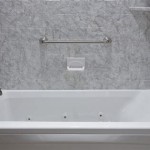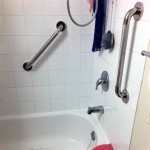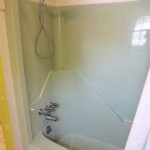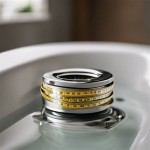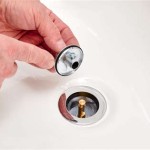How To Clean Your Bathtub Overflow Plate With Vinegar Water
The bathtub overflow plate serves the critical function of preventing water from exceeding a certain level in the tub, thus averting potential flooding. Due to its location and frequent exposure to water, soap scum, hair, and other debris, the overflow plate and the surrounding area can quickly become a breeding ground for bacteria and unsightly buildup. Regular cleaning of this feature is essential for maintaining a hygienic and aesthetically pleasing bathroom. A safe and effective method for cleaning the bathtub overflow plate involves the use of vinegar water.
Vinegar, particularly white vinegar, is a versatile cleaning agent known for its acidic properties. The acetic acid present in vinegar effectively dissolves mineral deposits, soap scum, and mildew, making it an ideal solution for tackling the grime that accumulates around the bathtub overflow plate. When diluted with water, vinegar becomes a gentler cleaning solution, less likely to damage certain surfaces while still maintaining its cleaning power. This article provides a comprehensive guide on how to clean a bathtub overflow plate using vinegar water, ensuring a thorough and safe cleaning process.
Preparing the Vinegar Water Solution
The first step in cleaning the bathtub overflow plate with vinegar water involves preparing the cleaning solution. The ideal ratio for vinegar water is typically a 1:1 mixture, meaning equal parts of white vinegar and water. This concentration provides a balance between cleaning effectiveness and minimizing potential damage to the bathtub's finish or the overflow plate itself.
To prepare the solution, gather the necessary materials: white vinegar, clean water, a measuring cup, and a container for mixing. Pour an equal amount of vinegar and water into the container. For example, one cup of white vinegar mixed with one cup of water will create a sufficient amount for cleaning a standard overflow plate. Adjust the quantities as needed depending on the size of the area to be cleaned. Stir the mixture gently to ensure even distribution of the vinegar and water. The vinegar water solution is now ready for use.
For particularly stubborn grime or heavy buildup, the concentration of vinegar in the solution can be increased slightly. However, it is crucial to test the solution on an inconspicuous area first to ensure that it does not cause any discoloration or damage. If the area remains unaffected, a stronger vinegar water solution can be used. It is generally not recommended to use undiluted vinegar, as its high acidity could potentially harm certain finishes or materials.
Alternative cleaning agents can be added to the vinegar water solution to enhance its cleaning power. For instance, a few drops of dish soap can help to break down grease and oily residues. Essential oils, such as tea tree oil or eucalyptus oil, can be added for their antibacterial and antifungal properties, as well as for their pleasant scent. When adding other cleaning agents, it is important to use them sparingly and to avoid mixing any chemicals that could create harmful fumes. Always research the compatibility of different cleaning agents before combining them.
Cleaning the Overflow Plate and Surrounding Area
Once the vinegar water solution is prepared, the next step involves applying it to the overflow plate and the surrounding area. This process requires careful attention to detail to ensure thorough cleaning and to prevent any damage to the bathtub or the overflow plate. Several methods can be used to apply the solution, depending on the type of buildup and the design of the overflow plate.
One common method involves using a spray bottle. Pour the vinegar water solution into a spray bottle and liberally spray the overflow plate and the surrounding area. Allow the solution to sit for several minutes, giving the vinegar time to dissolve the soap scum and mineral deposits. For heavily soiled areas, it may be necessary to let the solution sit for a longer period, up to 30 minutes. After the soaking period, use a scrub brush or a sponge to scrub the area, paying particular attention to the crevices and edges of the overflow plate. A toothbrush can be used for hard-to-reach areas or intricate designs.
Another method involves using a cloth or sponge soaked in the vinegar water solution. Dip a clean cloth or sponge into the solution and wring out the excess. Wipe the overflow plate and the surrounding area with the damp cloth or sponge, applying gentle pressure to remove any buildup. For stubborn stains or grime, hold the damp cloth or sponge over the affected area for a few minutes before scrubbing. This allows the vinegar water to penetrate the buildup and loosen it for easier removal.
For overflow plates with removable covers, consider removing the cover to clean it separately. This allows for more thorough cleaning of both the cover and the area behind it. Submerge the cover in the vinegar water solution and scrub it with a brush or sponge. Rinse the cover thoroughly with clean water before reattaching it to the overflow plate. When reattaching the cover, ensure that it is securely fastened to prevent leaks or damage.
After scrubbing the overflow plate and the surrounding area, rinse them thoroughly with clean water. Use a clean cloth or sponge to wipe away any remaining vinegar water solution. Ensure that all traces of the solution are removed to prevent any residue or discoloration. Dry the area with a clean towel to prevent water spots and to maintain a polished appearance.
Addressing Stubborn Buildup and Maintenance
In some cases, the buildup around the bathtub overflow plate may be particularly stubborn and resistant to cleaning with vinegar water alone. In such situations, additional cleaning methods or agents may be necessary to achieve a thorough cleaning. Furthermore, implementing preventative measures and regular maintenance can help to minimize the accumulation of buildup and simplify future cleaning efforts.
For stubborn buildup, consider using a baking soda paste in conjunction with the vinegar water solution. Baking soda is a mild abrasive that can help to scrub away tough stains and grime. Mix baking soda with a small amount of water to create a thick paste. Apply the paste to the affected area and let it sit for several minutes. Then, scrub the area with a brush or sponge, using the vinegar water solution to help break down the buildup. Rinse thoroughly with clean water after scrubbing.
Another effective method for removing stubborn buildup involves using a steam cleaner. The high-pressure steam can loosen and dissolve even the most resistant grime and mineral deposits. Direct the steam nozzle towards the overflow plate and the surrounding area, allowing the steam to penetrate the buildup. Then, use a brush or sponge to wipe away the loosened debris. Exercise caution when using a steam cleaner to avoid burns or damage to the surrounding surfaces.
To prevent future buildup around the bathtub overflow plate, implement regular maintenance practices. After each use of the bathtub, rinse the overflow plate and the surrounding area with clean water to remove any soap scum or hair. Wipe the area dry with a clean towel to prevent water spots and to inhibit the growth of mildew. Regularly inspect the overflow plate for any signs of buildup and clean it with vinegar water as needed.
Consider using a bathtub drain strainer to catch hair and other debris before they can accumulate around the overflow plate. Drain strainers are inexpensive and easy to install, and they can significantly reduce the amount of buildup that collects in the drain and around the overflow plate. Clean the drain strainer regularly to prevent clogs and to maintain optimal drainage.
By following these steps and incorporating regular maintenance practices, the bathtub overflow plate can be effectively cleaned and kept free of unsightly buildup, contributing to a cleaner and more hygienic bathroom environment. Using vinegar water as the primary cleaning solution offers a safe, effective, and environmentally friendly method for maintaining the cleanliness and appearance of this often-overlooked bathroom fixture.

How To Unclog A Bathtub Drain Without Chemicals

4 Ways To Clean A Bathtub Drain Wikihow

How To Clear A Clogged Sink Drain With Vinegar Baking Soda

4 Ways To Clean A Bathtub Drain Wikihow

Baking Soda Bleach And Vinegar Which Is Best For A Clean Bathtub 2025

How Do You Clean A Trip Lever Drain 3 Steps Done 1 Tom Plumber

How To Unclog A Bathtub Drain With Standing Water Naturally

How To Unclog A Bathtub Drain

How To Clean Tough Stains From A Bathtub 4 Easy Methods

How To Unclog A Bathtub Drain Without Chemicals
Related Posts

